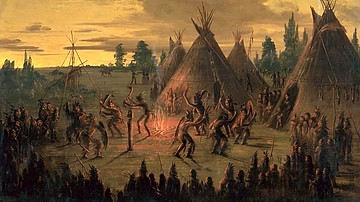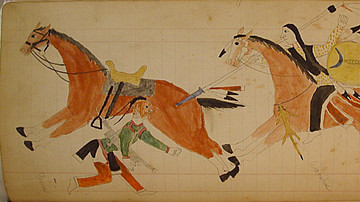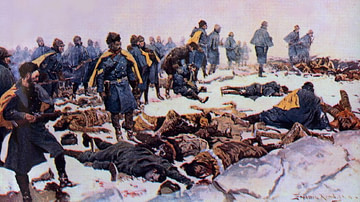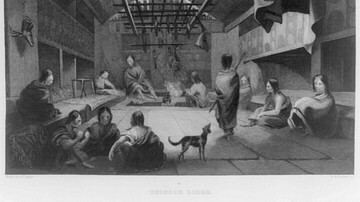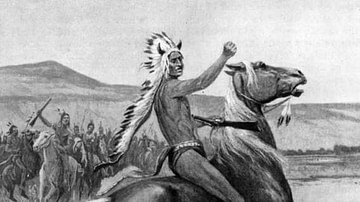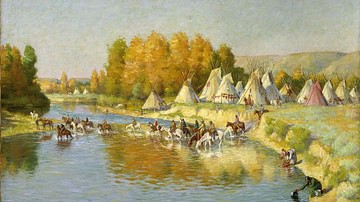The Cheyenne Creation Story is the account of the beginning of the world, the seasons, and the first people in the time before time when all was water, and nothing existed but the Creator and aquatic birds. There are many versions of the tale, but the most popular shares similarities with the Lakota Sioux Creation Story.
In that story, the Creator sends various animals (the loon, otter, beaver, and turtle) down to the bottom of the endless water to bring up the primordial mud to make the earth while, in the Cheyenne tale, only waterbirds are featured. The tale is also known as the Cheyenne and Arapaho Creation Story as it has also always been told – and still is – by the Arapaho Nation, a close ally of the Cheyenne. The Arapaho also have their own Creation Story, quite similar to the first one of the Cheyenne given below, as many of the legends and tales of the two Nations often are. A second Cheyenne creation tale, focusing on the origin of the people, is similar to the Mandan Creation Story, in which human beings are originally subterranean and emerge from the earth onto the upper land that becomes their ancestral home.
Creation stories of other Native American Nations share some similarities with all of the above, but all differ significantly in detail, conclusion, and specific message. A constant in these tales, however, is the presence of a Creator – explicitly mentioned or implied – responsible for the "earth we walk on" and all things in it. Another similarity in the tales is the absence of evil. Those aspects of existence that people fear and suffer such as sickness, difficulties, disappointments, and death are understood as part of the whole human condition as envisioned by the Creator from the start, not as a punishment for a "fallen condition" brought about by sin.
There is no date of composition assigned to any of these stories as they were passed down orally from generation to generation until they began to be recorded by white settlers in the 18th and, primarily, 19th centuries. Many of the Cheyenne tales, including this one, were written down by the anthropologist and historian George Bird Grinnell (l. 1849-1938). The following is taken from his work By Cheyenne Campfires, first published in 1926.
Text
The creation story of the Cheyenne tells of a being who was floating on the surface of the water. Water birds, swans, geese, ducks, and other birds that swim already existed and these were all about him. The person called to these birds and asked them to bring him some earth. They were glad to do so and agreed, one after another, to dive down through the water and see if they could find earth at the bottom. The larger birds dived in vain. They came up without anything, for they could not reach the bottom, but at last one small duck came to the surface with a little mud in its bill.
The bird swam to the being and put the mud in his hand, and the being took it and worked it with his fingers until it was dry, when he placed it in little piles on the surface of the water, and each little pile became land, and grew and grew and spread, until, as far as one could see, solid land was everywhere. Thus was created the earth we walk on.
After there was firm ground, the Creator took from his right side a rib and from it made a man. From the man's left side, he took a rib and from that made a woman. These two persons were made at the same place but, after they had been made, they were separated and the woman was put far in the north, and the man in the south.
Another creation story told me long ago by Ben Clark, who had married a Cheyenne woman and lived long with the tribe, says that once the Cheyenne were all under the ground, living in darkness. One day, a man saw far off a little spot of white. He approached it, and gradually it grew larger, and presently he found himself surrounded by the light, which blinded and frightened him. After a little time, however, he became used to this and, going back below the ground as he had come, told his fellows, and a part of them also came out from under the ground, and thereafter lived on the earth's surface. This suggests a tale told of the beginnings of the Mandan Indians.
After the Creator had made the two people, whom he placed far apart in the north and in the south, he stood between them with his back toward the rising sun. He said to them, "In that direction," pointing to the south, "You will find many sorts of animals and birds different from those which you will find in that direction," pointing to the north where the woman stood. "The birds that live in the south will go to the north in summer. Where the woman is it will be cold, and the grass and trees will not grow well. There will be hardly any of them, but where the man is everything will grow; trees, bushes, grass."
The woman in the north, though she was gray-haired, was not old. She never seemed to grow any older. The man in the south was young. He did not grow older.
In the north lives Ho im'a'ha, the Winter Man, the power that brings cold and snow and also brings sickness and death. He obeys the woman in the north. He is often spoken of in the stories and is said to have declared at a meeting of the supernatural beings that he would "take pity on no one." When, at this meeting, he spoke in this way, the Thunder, who represents the power in the south, declared that it would not do to let Ho im'a'ha have everything to say; so, with the help of the buffalo, the Thunder made fire and taught one of the culture heroes how to do the same thing.
He said to Sweet Medicine, "Get a stick and I will teach you something by which your people can warm themselves, can cook food, and with which they can burn things." He showed Sweet Medicine how to rest the point of the stick in the middle of a dried buffalo chip and then to rub it between his hands and twirl it fast. The young man did so and, after a time, the chip caught fire. Thus, by the help of the Thunder, the people were given something to use against the cold, something that would warm them.
The man and woman in the south and in the north appear to typify summer and winter, the man representing the sun or the Thunder, while the woman represents the power that wars against the sun.
Twice a year there is conflict between the Thunder and the Winter Man. At the end of summer, when the streams get low and the grass becomes yellow and dry, Ho im'a'ha comes down from the north and says to the Thunder: "Move back, move back, to the place from which you came. I want to spread all over the earth and freeze things and cover everything with snow." Then the Thunder moves back.
Toward spring, when the days begin to grow longer, the Thunder comes back from the south and says to Ho im'a'ha, "Go back, go back, to the place from which you came. I wish to warm the earth and to make the grass grow and all things to turn green." Then the Winter Man moves back, and the Thunder comes, bringing the rain; the grass grows, and all the earth is green. So, there is a struggle between these two powers. They follow each other back and forth.
The two first people, the man in the south and the woman in the north, never came together; but, later, other people were created and from them the earth was populated.
Commentary
Native American creation stories of the First People, including all the above, share a commonality in that there is no supernatural cause of evil. That which humans define as "bad" or "evil" such as sickness and death are naturally occurring and are caused by an entity acting according to its nature – which is neither good nor evil. Winter Man, in the Cheyenne Creation Story, is not an evil figure, only one who is interested in pursuing his own interests in covering the earth with snow and freezing things.
He says he will take no pity on anyone as an expression of his power: no one will get in the way of him doing as he pleases. Thunder opposes him but for his own reasons: he wants the earth to be warm and green. He gives the great prophet Sweet Medicine the gift of fire to thwart the designs of Winter Man and to further his own in warming the earth and, by extension, those who live on it, not because he especially cares for the people themselves. Warming the people is a means to an end, not the end goal.
Neither of these entities, nor the woman of the north or the man of the south, represent a power that opposes the Creator known to the Cheyenne as Maheo (Ma'heo'o), the Wise One Above, but act in accordance with their nature as directed by this Creator. The directions in the story represent this concept clearly as Maheo tells the man and woman that different animals and birds and different weather conditions will appear in both directions, but neither of these are, of themselves, better or worse than the other. The entirety of creation is therefore understood as good; if one decides to define the cold of the north as "bad", that is only one's own judgment.
Similarities to Mandan & Sioux Tales
Unlike many of the stories included in By Cheyenne Campfires, the above is given by Grinnell directly in his own voice, especially apparent in the fourth paragraph where he gives the tale of the origin of the Cheyenne and mentions the Mandan Creation Story. According to the Mandan (and many other nations), the people came from the earth, and so they belong to the earth and, especially, to that specific area they first emerged from.
The following is taken from Native-Languages.org, originally appearing in Myths and Legends of the Mississippi Valley and the Great Lakes by Katherine Judson, first published in 1914:
The Mandan were the People of the Pheasants. They were the first people in the world. At first, they lived in the earth. Now, in the dark Earth-land, they had many vines. Then, at last, one vine grew up through a hole in the Earth-plain, far above their heads. One of their young men at once went up the vine until he came out on the Earth-plain. He came out on the prairies, on the bank of a river, just where the Mandan village now stands.
He looked all about him. The Earth-plain was very beautiful. There were many buffalos there. He killed one with his bow and arrow and found it was good for food.
Then the young man returned to his people under the ground. He told them all he had seen. They held a council and then they began to climb up the vine to the Earth-plain. Some of the chiefs, and the young warriors, and many of the women went up. Then came a very fat woman. The chiefs said, "Do not go up." But she did, so the vine broke.
The Mandan were very sorry about this. Because no more could go up, the tribe on the Earth-plain is not very large. And no one could return to his village in the ground. Therefore, the Mandan built their village on the banks of the river. But the rest of the people remained underground.
In the Cheyenne tale, an aspect not dealt with fully in Grinnell's narrative, some of the people remain underground. Grinnell includes the detail of "and a part of them also came out from under the ground" without explaining what happened to the others who did not. In some versions of the tale, the reason is simply that some choose not to go up to the surface, in others, it is because they are unworthy, or afraid, or both. In the Mandan tale, however, it is simply because the vine breaks; meaning that there are still Mandan living below the earth – who would have come to the surface if they could have - that the Mandan regard as their living relatives who inhabit a world below their home and point of origin.
In the Lakota Sioux Creation Story, Wakan Tanka (the Great Mystery or Great Spirit) created a first world in which the humans forgot their divine nature and relation with other creatures, and so it was destroyed by fire. The second world was then created, but, again, humans behaved badly and so that was destroyed by a great flood. The third world (the world of this present era) was then created in a manner similar to the Cheyenne story above.
Wakan Tanka sends creatures down to the depths of the flooded world to bring up mud and, when the turtle finally succeeds, creation begins. The story serves not only to explain how the world began but also why the Sioux refer to North America (and, in some contexts the entire planet Earth) as "Turtle Island" as the land was built on the back of the accommodating turtle who retrieved the first mud and continues to carry it.
Conclusion
Just as the lowly turtle serves the Creator in the Sioux tale, the small duck does in the Cheyenne Creation Story. Human agency plays no part in the original creation and, when the Creator chooses to make people, the man is made from a part of Himself and the woman from a part of the man so that both share not only in the divine essence but also in the life force, the spiritual power, of each other.
In this same way, all of the animals, no matter how seemingly insignificant to humans they might appear, all share in this same divine essence and are regarded by the Creator with equal importance. The Cheyenne Creation Story highlights this concept throughout, not only through the actions of the small duck, but the understanding that nothing in the created world can be regarded as less important or worthy of respect than any other, as all things have come from a divine source.

